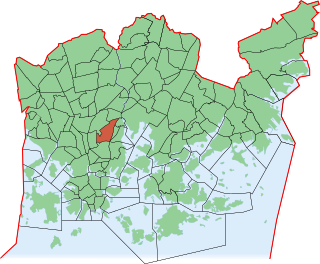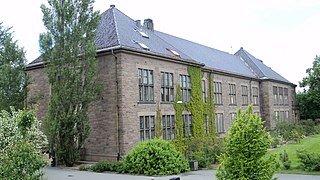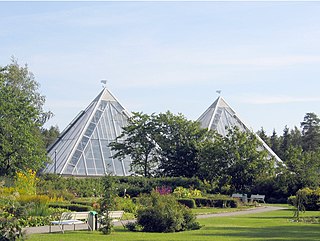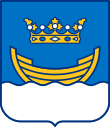
The University of Helsinki is a public research university located in Helsinki, Finland since 1829, but founded in the city of Turku in 1640 as the Royal Academy of Åbo, at that time part of the Swedish Empire. It is the oldest and largest university in Finland with the widest range of disciplines available. In 2020, around 31,600 students were enrolled in the degree programs of the university spread across 11 faculties and 11 research institutes.

The Jardin des plantes, also known as the Jardin des plantes de Paris when distinguished from other jardins des plantes in other cities, is the main botanical garden in France. The term Jardin des plantes is the official name in the present day, but it is in fact an elliptical form of Jardin royal des plantes médicinales, which is related to the original purpose of the garden back in the 17th century.

A herbarium is a collection of preserved plant specimens and associated data used for scientific study.

The University Botanical Garden is Norway's oldest botanical garden. It was first established in 1814 and is administrated by the University of Oslo. It is situated in the neighborhood of Tøyen in Oslo, Norway.

The Museu Paraense Emílio Goeldi (MPEG) is a Brazilian research institution and museum located in the city of Belém, state of Pará, Brazil. It was founded in 1866 by Domingos Soares Ferreira Penna as the Pará Museum of Natural History and Ethnography, and was later named in honor of Swiss naturalist Émil August Goeldi, who reorganized the institution and was its director from 1894 to 1905. It is now the "main research center on natural systems and sociocultural processes of the Brazilian Amazon." The museum and zoological park are listed as protected sites by both the National Institute of Historic and Artistic Heritage (IPHAN) and the Department of Historic, Artistic and Cultural Heritage of the state of Pará.

The Kumpula Campus is a science campus of University of Helsinki. The campus is located some four kilometres from the centre of Helsinki, in the Kumpula district. Completed in 2005, it currently provides study and research facilities for about 6,000 students and 1,000 teachers/researchers.

The National Museum of Ireland – Natural History, sometimes called the Dead Zoo, a branch of the National Museum of Ireland, is housed on Merrion Street in Dublin, Ireland. The museum was built in 1856 for parts of the collection of the Royal Dublin Society and the building and collection were later passed to the State.

The Natural History Museum in Lima, is Peru's most important museum of natural history. It was established in 1918 and belongs to the National University of San Marcos.

The Goulandris Museum of Natural History is a museum in Kifisia, a northeastern suburb of Athens, Greece. It was founded by Angelos Goulandris and Niki Goulandris in 1965 in order to promote interest in the natural sciences, to raise the awareness of the public, in general, and in particular to call its attention to the need to protect Greece's natural wildlife habitats and species in the danger of extinction.

The University of Helsinki Botanical Garden is an institution subordinate to the Finnish Museum of Natural History of the University of Helsinki, which maintains a collection of live plants for use in research and teaching. The Botanical Garden has two separate sites: one in Kaisaniemi and one in Kumpula.

The Hungarian Natural History Museum in Budapest, dating back to 1802, houses the largest natural history collections of Hungary and the region.

The Natural History Museum is one of the museums under the directorship of the Finnish Museum of Natural History, part of the University of Helsinki, in Helsinki, Finland.

Kumpula is a verdant neighbourhood in Helsinki, bordered by Eastern Pasila to the west, Vallila to the south, Käpylä and Koskela to the north and Toukola and Arabianranta to the east. As of January 1, 2003, Kumpula had approximately 3,600 inhabitants.
The Georgia Museum of Natural History is the U.S. state of Georgia's museum of natural history located in Athens, Georgia. The museum has eleven different collections in Anthropology, Arthropods, Botany, Geology, Herpetology, Ichthyology, Invertebrate, Mammalogy, Mycology, Ornithology, and Zooarchaeology. In addition, there are exhibitions, archives, and entertainment for children. The Exhibit Gallery is free and open to the public during scheduled hours. People can schedule a tour to visit the collections by appointment.

The Natural History Museum at the University of Oslo is Norway's oldest and largest museum of natural history. It is situated in the neighborhood of Tøyen in Oslo, Norway.

The Botanical Garden of the University of Oulu is one of the northernmost scientific gardens in the world. Botanical Garden collection of plants is maintained for teaching and research purposes and it is open to the public.

The Natural History Museum of Denmark is a natural history museum located in Copenhagen, Denmark. It was created as a 1 January 2004 merger of Copenhagen's Zoological Museum, Geological Museum, Botanical Museum and Central Library, and Botanical Gardens. It is affiliated with the University of Copenhagen.

A scientific collection is a collection of items that are preserved, catalogued, and managed for the purpose of scientific study.

The Estonian Museum of Natural History is the Estonian national museum for natural history. It is situated in Tallinn's Old Town.




















